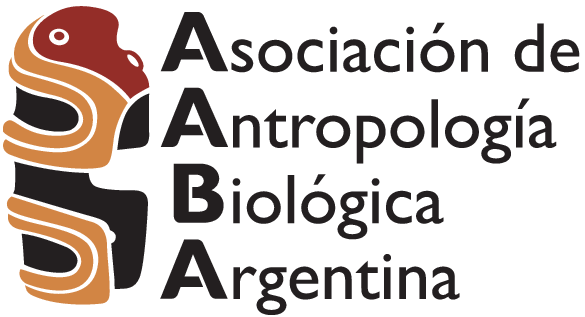Inestabilidad del desarrollo en estructuras craneofaciales de poblaciones humanas sudamericanas/Developmental instability of craniofacial structures of Southamerican human populations
Resumen
RESUMEN Diversos factores genéticos y ambientales pueden actuar sobre los mecanismos que amortiguan el efecto de perturbaciones aleatorias durante el desarrollo, resultando en un aumento de la inestabilidad del desarrollo (ID) y de la variación a nivel individual. El objetivo de este trabajo es analizar el grado y el patrón de asimetría fluctuante (AF) en el cráneo, como una medida de ID, en poblaciones con distinto tipo de subsistencia. Asimismo, se evalúa la existencia de diferencias entre la base, la bóveda y el esqueleto facial. Se relevaron landmarks tridimensionales sagitales y bilaterales en 109 cráneos de Chubut, San Juan y SO de Pampa. El método de Superposición Procrustes Generalizado fue usado para extraer los componentes simétrico y asimétrico de la forma. Los análisis preliminares indicaron que el error de medición y la asimetría direccional dan cuenta de un porcentaje reducido de la variación total, mientras que la AF explica entre el 10 y el 15% de la misma. La magnitud de AF –estimada como la distancia Procrustes entre las configuraciones originales y sus imágenes reflejadas– de la bóveda y la región facial resultó mayor en San Juan, mientras que la base no presentó diferencias entre las muestras. Los patrones de forma del componente asimétrico indican que la muestra de Chubut se diferencia en la base y la cara, mientras que la de San Juan se diferencia en la bóveda. En resumen, los resultados obtenidos sugieren variación modular en la ID del cráneo y diferencias entre las muestras analizadas.
PALABRAS CLAVE asimetría fluctuante; morfometría geométrica; inestabilidad del desarrollo; subsistencia
ABSTRACT Regulatory mechanisms acting on the effect of stochastic perturbations during development can be modulated by diverse environmental and genetic factors, resulting in increased developmental instability (DI) and individual variation. It has been suggested that subsistence-related ecological changes could have significantly influenced craniofacial morphology of South American aboriginal populations. In this paper, the magnitude and pattern of fluctuating asymmetry, used as a DI measure, are compared among the samples with different subsistence strategies and among 3 craniofacial modules. Midline and bilateral 3D landmarks were recorded in 109 skulls from Chubut, San Juan and SW of the Pampean region. The Generalized Procrustes Superimposition method was used to extract the symmetric and asymmetric components of shape. Preliminary analyses show that measurement error and directional asymmetry account for a reduced amount of total variation, while FA explains 10 to 15% of it. FA magnitude –estimated as the Procrustes distances between the original configurations and their reflections– found in the vault and facial region was higher for San Juan sample, while the cranial base did not show any differences among samples. Shape patterns in the asymmetric component show that Chubut sample is different from the others as regards cranial base and facial configurations, while San Juan is different in relation to vault. Results suggest modular variation in skull DI and differences among the analyzed samples.
KEY WORDS fluctuating asymmetry; geometric morphometrics; developmental instability; subsistence
doi: 10.17139/raab.2014.0016.01.03
Descargas
Referencias
Atchley WR, Hall BK. 1991. A model for development and evolution of complex morphological structures. Biol Rev 66:101-157. doi:10.1111/j.1469-185X.1991.tb01138.x
Béguelin M. 2011. Stature estimation in a central Patagonian prehispanic population: development of new models considering specific body proportions. Int J Osteoarchaeol 21:150-158. doi:10.1002/oa.1117
Bigoni L, Krajíček V, Sládek V, Velemínský P, Velemínská J. 2013. Skull shape asymmetry and the socioeconomic structure of an early medieval central European society. Am J Phys Anthropol 150:349-364. doi:10.1002/ajpa.22210
Bookstein FL. 1991. Morphometric tools for landmark data: geometry and biology. New York: Cambridge University Press.
Bookstein FL. 1997. Landmark methods for forms without landmarks: morphometrics of group differences in outline shape. Med Image Anal 1:225-243. doi:10.1016/S1361-8415(97)85012-8
Buikstra JE, Ubelaker D. 1994. Standards for data collection from human skeletal remains. En: Proceedings of a seminar at the field Museum of Natural History. Arkansas: Arkansas Archaeological Survey Research
Cocilovo JA, Di Rienzo J. 1984. Un modelo biológico para el estudio del poblamiento prehispánico del territorio argentino. Correlación fenético-espacial. Relac Soc Argent Antropol XVI:119-135.
Cocilovo JA, Varela H. 2006. La asimetría bilateral y la inestabilidad del desarrollo. Un caso de aplicación en restos óseos humanos del sitio Punta de Teatinos (Norte de Chile). Rev Arg Antrop Biol 8:121-144.
Debat V, Bloyer S, Faradji F, Gidaszewski N, Navarro N, Orozco-terWengel P, Ribeiro V, Schlötterer C, Deutsch JS, Peronnet F. 2011. Developmental stability: a major role for Cyclin G in Drosophila melanogaster. PLoS Genet 7:e1002314. doi: 10.1371/journal.pgen.1002314
DeLeon VB, Richtsmeier JT. 2009. Fluctuating asymmetry and developmental instability in sagittal craniosynostosis. Cleft Palate Craniofac J 46:187-196. doi:10.1371/journal.pgen.1002314
DeLeon VB. 2007. Fluctuating asymmetry and stress in a medieval Nubian population. Am J Phys Anthropol 132:520-534. doi:10.1597/08-001.1
Gawlikowska A, Szczurowski J, Czerwiński F, Miklaszewska D, Adamiec E, Dzięciołowska E. 2007. The fluctuating asymmetry of mediaeval and modern human skulls. Homo 58:159-172. doi:10.1016/j.jchb.2006.10.001
Gil AF, Neme GA, Tykof RH. 2010. Isótopos estables y consumo de maíz en el centro occidente argentino: tendencias temporales y espaciales. Chungará 42:497-513. doi:10.4067/S0717-73562010000200011
Goebel T, Waters MR, O’Rourke DH. 2008. The late Pleistocene dispersal of modern humans in the Americas. Science 319:1497-1502. doi:10.1126/science.1153569
Gómez Otero JE. 2007. Dieta, uso del espacio y evolución en poblaciones cazadoras-recolectoras de la costa centro-septentrional de Patagonia durante el Holoceno medio y tardío. Tesis Doctoral Inédita. Facultad de Filosofía y Letras. Universidad de Buenos Aires. Buenos Aires. Argentina.
Gonzalez PN, Perez SI, Bernal V. 2011. Ontogenetic allometry and cranial shape diversification among human populations from South America. Anat Rec 294:1864-1874. doi:10.1002/ar.21454
González-José R, Ramírez-Rozzi F, Sardi M, MartínezAbadías N, Hernández M, Pucciarelli HM. 2005. Functional-cranial approach to the influence of economic strategy on skull morphology. Am J Phys Anthropol 128:757-771. doi:10.1002/ajpa.20161
Hallgrímsson B, Lieberman DE. 2008. Mouse models and the evolutionary developmental biology of the skull. Integr Comp Biol 48:373-384. doi:10.1093/icb/icn076
Hallgrímsson B, Miyake T, Wilmore K, Hall BKH. 2003. The embryological origins of developmental stability: size, shape and fluctuating asymmetry in prenatal random bred mice. J Exp Zool (MDE) 296B:40-57. doi:10.1002/jez.b.15
Hershkovitz I, Ring B, Kobyliansky E. 1992. Craniofacial asymmetry in Bedouin adults. Am J Hum Biol 4:83-92. doi:10.1002/ajhb.1310040111
Howells WW. 1937. The designation of the principle anthropometric landmarks on the head and skull. Am J Phys Anthropol. 22:477-494.
Howells WW. 1973. Cranial variation in man. A study by multivariate analysis of patterns of differences among recent human populations. Pap Peabody Mus Am A. 67.
Humphrey LT. 1998. Growth patterns in the modern human skeleton. Am J Phys Anthropol 105:57-72. doi:10.1002/(SICI)1096-8644(199801)105:1<57::AIDAJPA6>3.0.CO;2-A
Klingenberg C. 2003. A developmental perspective on developmental instability : theory, models and mechanisms. En: Polak M, editor. Developmental instability: causes and consequences. New York: Oxford University Press. p 1-26.
Klingenberg CP. 2011. MorphoJ: an integrated software package for geometric morphometrics. Mol Ecol Resour 11:353-357. doi:10.1111/j.1755-0998.2010.02924.x
Klingenberg CP, Barluenga M, Meyer A. 2002. Shape analysis of symmetric structures: quantifying variation among individuals and asymmetry. Evolution 56:1909-1920. doi:10.1111/j.0014-3820.2002.tb00117.x
Klingenberg CP, McIntyre GS. 1998. Geometric morphometrics of developmental instability: analyzing patterns of fluctuating asymmetry with procrustes methods. Evolution 52:1363-1375. doi:10.2307/2411306
Lehmann Nitsche R. 1910. Catálogo de la sección Antropología del Museo de La Plata. Buenos Aires: Coni Hnos.
Leung B, Forbes, Houle D. 2000. Fluctuating asymmetry as a bioindicator of stress: comparing efficacy of analyses involving multiple traits. Am Nat 155:101-115. doi:10.1086/303298
Li K-C. 1991. Sliced inverse regression for dimension reduction. J Am Stat Assoc 86:316-327. doi:10.1080/01621459.1991.10475035
McBratney-Owen B, Iseki S, Bamforth SD, Olsen BR, Morriss-Kay GM. 2008. Development and tissue origins of the mammalian cranial base. Dev Biol 322:121-132. doi:10.1016/j.ydbio.2008.07.016
Medeot EA, Cocilovo JA, Varela H. 2008. Varianza ambiental y estabilidad del desarrollo en la población prehispánica de las Pirguas (Salta, Argentina). Lat Am Antiq 19:146-157.
Morriss-Kay GM. 2001. Derivation of the mammalian skull vault. J Anat 199:143-151. doi:10.1046/j.1469-7580.2001.19910143.x
Nijhout H, Davidowitz G. 2003. Developmental perspectives on phenotypic variation, canalization, and fluctuating asymmetry. En: Polak M, editor. Developmental instability. Causes and consequences. New York: Oxford University Press. p 3-13.
Nijhout HF. 2003. The control of body size in insects. Dev Biol 261:1-9. doi:10.1016/S0012-1606(03)00276-8
Palmer A, Strobeck C. 1986. Fluctuating asymmetry: measurement, analysis, patterns. Annu Rev Ecol Evol Syst 17:391-421. doi:10.1146/annurev.es.17.110186.002135
Palmer A, Strobeck C. 1992. Fluctuating asymmetry as a measure of developmental stability: implications of non-normal distributions and power of statistical tests. Acta Zool Fenn 191:57-72.
Palmer A, Strobeck C. 2003. Fluctuating asymmetry analyses revisited. En: Polak M, editor. Developmental instability: causes and consequences. New York: Oxford University Press. p 279-319.
Palmer AR. 1994. Fluctuating asymmetry analyses: a primer. En: Markow TA, editor. Developmental instability: its origins and evolutionary implications. Contemporary issues in genetics and evolution. Tempe, Arizona: Springer Netherlands. p 335-364.
Palmer M, Linde M, Morales-Nin B. 2010. Disentangling fluctuating asymmetry from otolith shape. Mar EcolProg Ser 399:261-272. doi:10.3354/meps08347
Perez SI, Monteiro LR. 2009. Nonrandom factors in modern human morphological diversification: a study of craniofacial variation in southern South American populations. Evolution 63:978-993. doi:10.1111/j.1558-5646.2008.00539.x
Perez SI, Bernal V, Gonzalez PN. 2006. Differences between sliding semi-landmark methods in geometric morphometrics, with an application to human craniofacial and dental variation. J Anat 208:769-784. doi:10.1111/j.1469-7580.2006.00576.x
Perez SI, Lema V, Diniz-Filho JAF, Bernal V, Gonzalez PN, Gobbo D, Pucciarelli HM. 2011. The role of diet and temperature in shaping cranial diversification of South American human populations: an approach based on spatial regression and divergence rate tests. J Biogeogr 38:148-163. doi:10.1111/j.1365-2699.2010.02392.x
Polak M. 2003. Developmental instability: causes and consequences. New York: Oxford University Press.
R Core Team. 2013. R: a language and environment for statistical computing. R foundation for statistical computing, Vienna, Austria. Disponible en: http://www.Rproject.org
Richtsmeier JT, Iii TMC, Lele SR. 2005. An invariant approach to the study of fluctuating asymmetry: developmental instability in a mouse model for Down syndrome. En: Slice DE, editor. Modern morphometrics in physical anthropology. Developments in primatology: progress and prospects. New York: Springer. p 187-212.
Rothhammer F, Silva C. 1990. Craniometrical variation among South American prehistoric populations: climatic, altitudinal, chronological, and geographic con tributions. Am J Phys Anthropol 82:9-17. doi:10.1002/ajpa.1330820103
Sardi ML, Ramírez Rozzi F, González-José R, Pucciarelli HM. 2005. South Amerindian craniofacial morphology: diversity and implications for Amerindian evolution. Am J Phys Anthropol 128:747-756. doi:10.1002/ajpa.20235
Schaefer K, Lauc T, Mitteroecker P, Gunz P, Bookstein FL. 2006. Dental arch asymmetry in an isolated Adriatic community. Am J Phys Anthropol 129:132-142. doi:10.1002/ajpa.20224
Sheets HD, Covino KM, Panasiewicz JM, Morris SR. 2006. Comparison of geometric morphometric outline methods in the discrimination of age-related differences in feather shape. Front Zool 3:15. doi:10.1186/1742-9994-3-15
Sperber GH. 2001. Craniofacial development. New York: B.C. Decker. Steele J, Politis G. 2009. AMS 14C dating of early human occupation of southern South America. J Archaeol Sci 36:419-429. doi:10.1016/j.jas.2008.09.024
Van Dongen S. 1999. Accuracy and power in fluctuating asymmetry studies: effects of sample size and number of within-subject repeats. J Evolution Biol 12:547-550. doi:10.1046/j.1420-9101.1999.00062.x
Van Valen L. 1962. A study of fluctuating asymmetry. Evolution 16:125-142. doi:10.2307/2406192
Wagner GP, Altenberg L. 1996. Perspective: complex adaptations and the evolution of evolvability. Evolution 50:967-976. doi:10.2307/2410639
Wagner GP, Pavlicev M, Cheverud JM. The road to modularity. Nat Rev Genet 8:921-931. doi:10.1038/nrg2267
Willmore KE, Klingenberg CP, Hallgrímsson B. 2005. The relationship between fluctuating asymmetry and environmental variance in Rhesus macaque skulls. Evolution 59:898-909. doi:10.1111/j.0014-3820.2005. tb01763.x
Zeballos E. 1881. Descripción amena de la República Argentina. Viaje al país de los Araucanos. Buenos Aires: Peuser
Descargas
Publicado
Número
Sección
Licencia
La RAAB es una revista de acceso abierto tipo diamante. No se aplican cargos para la lectura, el envío de los trabajos ni tampoco para su procesamiento. Asímismo, los autores mantienen el copyright sobre sus trabajos así como también los derechos de publicación sin restricciones.






























